Don't wanna be here? Send us removal request.
Text
Hans Bjelkhagen

Hans Bjelkhagen stands as a prominent figure in the dynamic realm of holography, where his multifaceted contributions encompass the roles of physicist, researcher, and artist. Armed with a Ph.D. in Physics from the esteemed Royal Institute of Technology in Stockholm, Sweden, Bjelkhagen has cultivated an illustrious career marked by academic prowess and groundbreaking advancements in the field.
Throughout his academic journey, Bjelkhagen has held distinguished positions, including roles at institutions such as the University of Cambridge and the Royal College of Art in London. His influence extends beyond the lecture hall, as he actively engages in research that has propelled holography to new heights. His scientific inquiries delve into holographic techniques, recording materials, and the varied applications of holography, positioning him as a trailblazer in the fusion of science and art.
Notably, Bjelkhagen has embraced the dual role of mentor and researcher, nurturing the next generation of minds fascinated by holography. His teachings have left an indelible mark on students eager to explore the potential of holographic technology. Beyond the laboratory, Bjelkhagen's impact is felt in practical applications of holography, ranging from advancements in medical imaging to the development of cutting-edge three-dimensional display technologies.
A distinctive aspect of Bjelkhagen's career lies in his foray into holographic art, where he seamlessly merges scientific concepts with artistic expression. His holographic artworks stand as captivating manifestations of this convergence, showcasing his ability to transcend the boundaries between disciplines. In recognition of his profound contributions, Bjelkhagen has earned accolades within the holographic community, solidifying his status as a luminary in both scientific and artistic spheres.
While his past achievements have garnered acclaim, Hans Bjelkhagen's current endeavors, recent projects, and any additional honors can be explored through up-to-date publications, academic profiles, and institutional channels associated with his illustrious career. As the field of holography continues to evolve, Bjelkhagen remains a pivotal figure at the forefront of innovation and exploration.
0 notes
Text
Dan Schweitzer



Dan Schweitzer stands out as an exceptional figure in the realm of holography, seamlessly blending the roles of a visionary holographer and an accomplished artist. Renowned for his dedication to pushing the boundaries of artistic expression, Schweitzer's work is a testament to the marriage of technical expertise and creative brilliance. His holographic artworks, characterized by intricate and detailed scenes, showcase a mastery of the medium that goes beyond mere experimentation.
In the vibrant world of holography, Schweitzer's contributions are nothing short of groundbreaking. His artistic vision extends to the very core of holographic techniques, where he fearlessly explores the nuances of light and perception. What sets Schweitzer apart is not just his technical finesse but the profound impact of his work in creating immersive holographic installations. Through the lens of holography, Schweitzer transforms ordinary scenes into captivating, three-dimensional experiences, providing viewers with a truly unique and awe-inspiring journey.
Holography, under Schweitzer's artistic guidance, transcends its technical confines and becomes a captivating intersection of technology and creativity. His ability to capture scenes with a remarkable three-dimensional quality not only showcases his technical prowess but also highlights his gift for storytelling through this dynamic medium. Schweitzer's work stands as a testament to the transformative power of holography, offering audiences an unparalleled and enchanting visual experience that lingers long after the holographic scenes unfold.
0 notes
Text
Quantum Holography
Quantum holography represents a fascinating interdisciplinary field at the intersection of quantum mechanics and holography, seeking to unravel the fundamental mysteries of the universe. At its core, this concept extends traditional holography to the quantum realm, where quantum states and phenomena are explored through holographic principles. One of the central tenets of quantum holography is the holographic principle, suggesting that the information within a particular volume of space can be encoded on a lower-dimensional boundary of that space. In the quantum context, researchers delve into whether the information content of a quantum system can be intricately encoded on its boundary, offering insights into the nature of quantum reality.
A significant development within quantum holography is the AdS/CFT correspondence, proposed by Juan Maldacena. This correspondence establishes an intriguing equivalence between a gravitational theory in a higher-dimensional space (Anti-de Sitter space) and a non-gravitational conformal field theory on its boundary. The AdS/CFT correspondence has opened avenues for understanding the relationships between quantum field theory, gravity, and holography.
Quantum holography also plays a pivotal role in addressing the Black Hole Information Paradox, a longstanding puzzle concerning the conservation of information in black holes. The exploration of how quantum entanglement might encode the geometry of space-time forms a crucial aspect of quantum holography. Researchers investigate the intricate connections between entanglement structures of quantum particles and the underlying spatial arrangement, offering potential insights into the quantum nature of gravity.
String theory, which seeks to unify quantum mechanics and general relativity, is often intertwined with quantum holography. Theoretical explorations within this framework aim to understand the fundamental nature of the universe by incorporating extended entities known as strings, and holographic principles become a lens through which researchers approach the elusive quest for a unified theory.
While quantum holography is primarily theoretical, it holds the promise of revolutionizing our comprehension of quantum gravity and the fabric of space-time. The quest for experimental validation and deeper theoretical insights into the holographic nature of quantum systems continues, making quantum holography a vibrant area of exploration at the forefront of theoretical physics. For the latest developments, researchers are encouraged to delve into contemporary literature, scientific journals, and conferences in this rapidly evolving field.
0 notes
Text
3D printing with holograms

Holographic 3D printing represents a cutting-edge approach to additive manufacturing, where holography is harnessed to create intricate three-dimensional structures. In this innovative process, holographic patterns are projected onto a light-sensitive material or photopolymer, incorporating information about the desired 3D object. Unlike traditional layer-by-layer 3D printing, holographic 3D printing allows for the simultaneous solidification of entire layers, potentially enhancing speed and precision in the manufacturing process.
The holographic projections initiate a chemical or physical reaction in the photosensitive material, resulting in the layer-wise construction of the 3D object. This technique addresses challenges associated with geometric complexity, enabling the fabrication of highly detailed and intricate structures. Despite its promises, holographic 3D printing comes with its set of challenges, including the need for suitable materials that respond effectively to holographic patterning and the requirement for advanced optics to achieve high resolution and accuracy.
The applications of holographic 3D printing span various industries, including manufacturing, healthcare, electronics, and aerospace. The potential to efficiently create complex components opens up new avenues for design and fabrication. Ongoing research and development efforts focus on refining holographic projection systems, optimizing materials, and exploring novel applications. For the latest developments in this dynamic field, researchers are advised to consult recent research papers, conference proceedings, and industry updates, ensuring an up-to-date understanding of holographic 3D printing's advancements and implications.
0 notes
Text
The history behind holograms

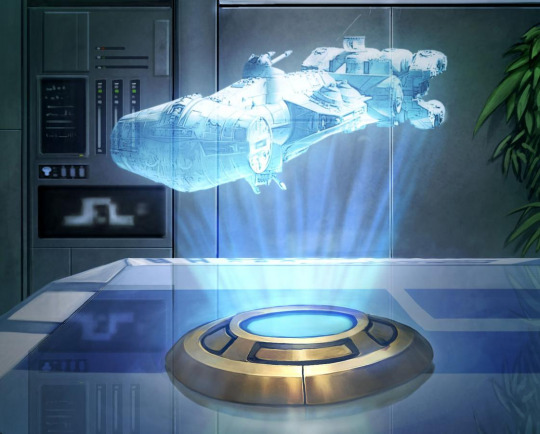

The history of holography commenced in 1947 when physicist Dennis Gabor introduced the theoretical concept, envisioning an improvement for electron microscopy. However, practical application awaited the advent of the laser in 1960, providing the necessary coherent light source for holographic recording. The groundbreaking work of Emmett Leith and Juris Upatnieks in 1962 marked a turning point, leading to the first practical holographic system utilizing lasers.
Throughout the 1960s and 1970s, researchers like Stephen Benton pushed the boundaries, achieving color holography and expanding the technology's potential. Yuri Denisyuk's introduction of reflection holography in 1962 increased practicality by enabling hologram viewing under white light. Pulse laser holography, emerging in the 1970s, allowed for the recording of holograms capturing dynamic scenes, opening new applications in fields like medicine.
The 1990s witnessed a transition to digital holography, leveraging advancements in digital technology. Digital holography, utilizing digital sensors and computing, enhanced storage, transmission, and manipulation of holographic data. As the 21st century unfolded, efforts concentrated on practical holographic displays for applications in entertainment, education, and medical imaging. Ongoing research and technological innovations, such as spatial light modulators and improved materials, contribute to the continuous evolution of holography, promising advancements in image quality, cost reduction, and broader applications in augmented reality, virtual reality, and 3D printing. The journey from Gabor's theoretical groundwork to present-day practical applications exemplifies the remarkable progress in the field of holography.
0 notes
Text
The science behind holograms

Holography is a fascinating scientific technique that enables the creation of three-dimensional images through the principles of interference and diffraction. The foundation of holography lies in the coherence of light, specifically laser light, which exhibits a consistent phase relationship among its waves. This coherence is crucial for generating the interference patterns necessary for holographic imaging.
To create a hologram, a laser beam is split into two components: the object beam and the reference beam. The object beam is directed onto the subject, and the light scattered off the object combines with the reference beam. The resulting interference pattern, containing both amplitude and phase information, is recorded on a photosensitive medium such as a holographic plate or film.
Unlike traditional photographs that only capture intensity information, holography preserves the wavefront information of light, allowing for the recreation of a 3D image. When the hologram is later illuminated with a coherent light source, such as the same laser used during recording, the interference pattern is reconstructed. This reconstruction results in the perception of a lifelike 3D image, complete with parallax, enabling viewers to observe the holographic object from different angles.
Holography has found diverse applications, ranging from art and security to data storage and medical imaging. The ability to create realistic 3D images with parallax has made holography an invaluable tool in various fields, continually advancing as technology evolves.
0 notes
Text
Final Hologram

Creating a hologram was a new challenge for me, and initially, I was uncertain about how to approach it. However, disregarding the bottom part since it won't be included, I don't think it turned out as poorly as I expected. While I'm not particularly thrilled with the result, it surpasses my initial expectations. The hologram lines, in my view, successfully convey the Star Wars reference I aimed for. Additionally, I incorporated subtle details like a small house visible when navigating around the mountain—something I found quite satisfying. Moreover, the inclusion of a few meaningful trees adds a layer of significance to the narrative, contributing to an overall outcome that exceeded my initial apprehensions.
0 notes
Text
Looking at Logos for fonts


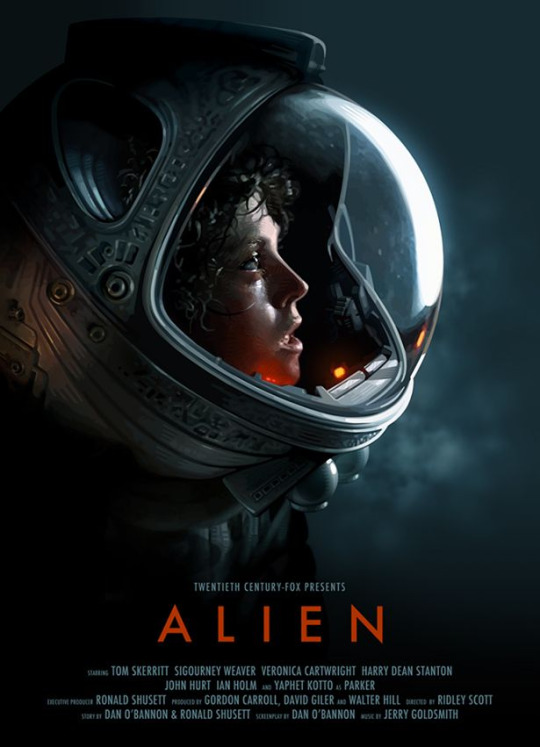
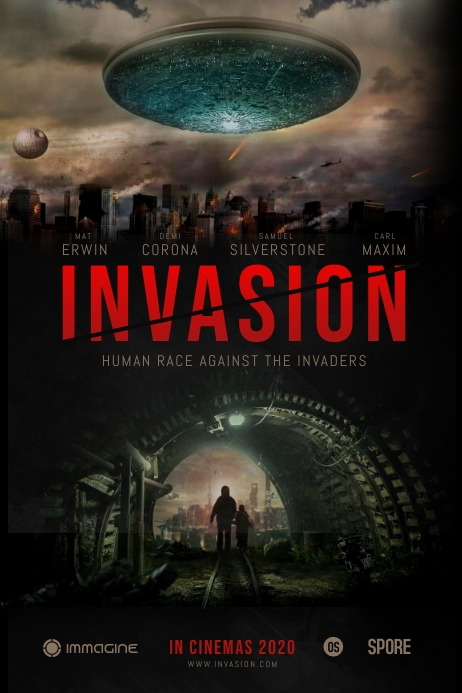
These served as some of the inspirational images guiding the creation of text atop the hologram, aiming to evoke a sense of "Danger" or "Caution." The use of the "Invasion" font, particularly in red, intensifies the feeling of danger, as red is commonly associated with caution. I found the font and spacing of "Prometheius" intriguing, and my goal was to seamlessly blend elements from both "Invasion" and "Prometheius." I believe this fusion was nearly successful, leveraging the font style of "Invasion" and the spacing from "Prometheius."
Taking cues from "Another Earth" and "Alien," I appreciated the effective use of spacing in text. While the font of "Alien" may not inherently convey danger, the color and spacing contribute significantly to capturing the envisioned theme. Overall, I am pleased with how these influences came together in the design, successfully transmitting a sense of caution and danger.
0 notes
Text
Final Render

Here is the final result of the scene. Overall, I'm quite satisfied with it, though I do think incorporating a few more clouds might have added an extra touch. However, I didn't want to overshadow the prominence of the mountains too much.
0 notes
Text
Clouds for a few extra detail







To enhance the scene, I introduced a "sun" light, casting a warm, orange hue that added depth and visual appeal. Despite this improvement, I sensed a need for further detail. To address this, I turned my attention to incorporating clouds using modifiers. Breaking down a mesh into a cloud-like shape, I adjusted the display to "Bounds" to initiate a transparent effect. The chosen orange color persisted to maintain the sunset aesthetic, and the introduction of "volume scatters" enhanced the cloud-like texture. This adjustment brought about a pleasing outcome, and at this point, I felt the scene was nearing its completion.
0 notes
Text
Adding textures and details





Upon completing the tree additions, I moved on to incorporating textures into the scene. The first focus was the sky, and I once again employed "geometry nodes" to achieve the desired effect. Introducing the "Mapping" node allowed me to fine-tune the sun's placement, ensuring it peeked through the mountains as intended. Adding color to the trees was the next step, contributing to the overall cohesion of the image. However, upon further review, I sensed a potential excess of trees, prompting me to readjust their quantity in the scene. As I fine-tuned this aspect, I couldn't help but appreciate how the image started to take shape, and I found myself pleased with the emerging result.
0 notes
Text
Adding trees
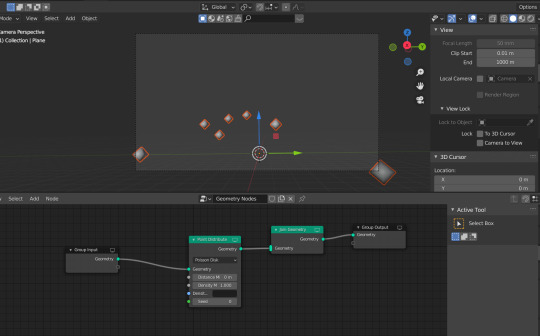

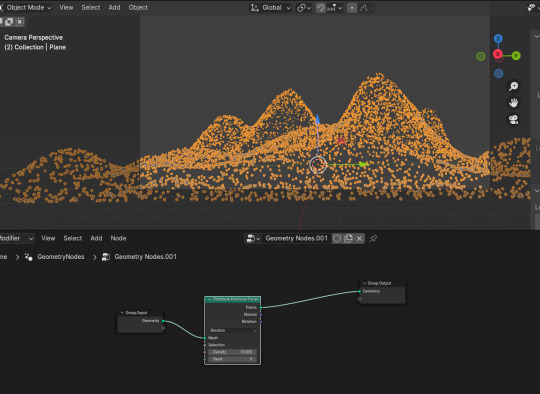



Once I established the foundation for the mountains, I noticed they appeared a bit plain, prompting me to introduce trees into the scene. Learning from a past project where overly detailed trees with particles caused usability issues on various computers, I opted for a different approach. This time, I utilized "geometry nodes" to generate a textured representation of a tree, achieving a semi-realistic look from a distance. It took some time to navigate the process of separating the trees, but ultimately, incorporating a "Random Value" node proved to be the key. This node facilitated a random distribution of trees in different areas while ensuring an even separation.
0 notes
Text
Modelling my own mountains






To start shaping my mountain model, I introduced a basic plane into the scene. By applying a series of modifiers, I initiated the process of crafting a textured, uneven surface. Using the "Subdivision Surface" modifier, I began partitioning the mountains into distinct sections. Afterward, I fine-tuned each section, molding them into various shapes to form the layered structure of the mountains. This process proved to be straightforward and didn't demand a significant amount of time to accomplish.
0 notes
Text
Inspiration i've been using to model my mountains




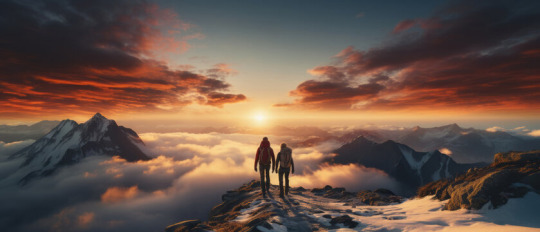
Embarking on the creative journey of crafting the mountainscape, I delved into a contemplative exploration of inspiration resonating within the recesses of my imagination. A crystallized vision began to take shape, one that involved mountains adorned with clouds and, maybe, the gentle radiance of the sun breaking through. Simultaneously, the allure of incorporating the trees showcased in the second photo also is peaking my curiosity.
Choosing to add those trees wasn't just for the aesthetics, it was a deliberate move to make the mountain scene appear more realistic. I want to go beyond a simple picture and bring in a touch of authenticity. Including the trees added a bit of detail and make the whole thing more intricate. My goal is to create something simple but with a realistic vibe, blending elements that capture both simplicity and authenticity. I'm excited about turning this idea into art and confident it will be a harmonious mix of simplicity and lifelike details.
0 notes
Text
Star Trek


Exploring the vast cosmos of Star Trek, I find myself captivated by the futuristic portrayal of holograms within the franchise. Star Trek, a groundbreaking science fiction series, has consistently featured holographic technology as a staple in its vision of the future. One notable example is the "holodeck," a virtual reality space where incredibly realistic holographic environments are generated for the crew's recreation and training.
In Star Trek, holograms aren't just static images but dynamic, interactive constructs that contribute to the immersive nature of the narrative. Characters engage with holographic simulations, blurring the lines between reality and the artificial environments created by advanced technology. The holodeck, in particular, stands out as a space where the crew can experience everything from historical reenactments to adventurous scenarios, showcasing the versatility and creativity of holographic technology in the Star Trek universe.
Drawing inspiration from Star Trek's holographic marvels, I'm eager to infuse our project with a touch of futuristic storytelling. The dynamic and interactive nature of Star Trek's holograms aligns with my vision for creating a visually engaging and immersive experience. The idea of using holograms to go beyond static representations and instead craft dynamic, interactive environments resonates with my creative ambitions.
I envision incorporating holographic elements that evoke a sense of exploration and innovation, much like the holodeck adventures in Star Trek. Whether it's creating holographic landscapes or interactive simulations, I aim to capture the essence of Star Trek's holographic storytelling. The franchise not only serves as a source of inspiration but also as a guide for pushing the boundaries of what holographic technology can achieve in storytelling and artistic expression. Star Trek's holograms have left an indelible mark on my creative vision, inspiring me to explore new dimensions and possibilities within my project.
0 notes
Text
Holography
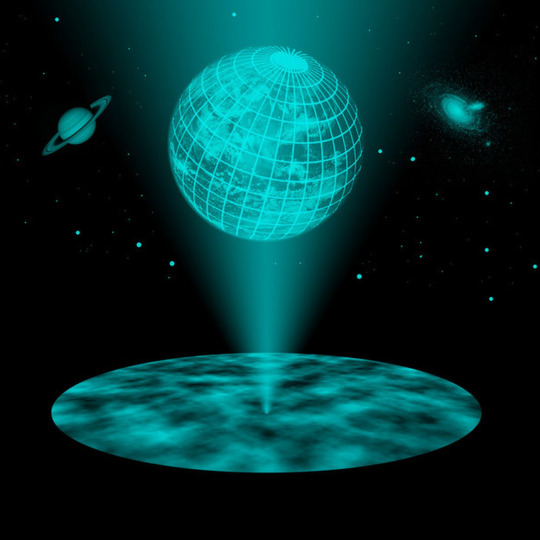


The fascinating journey of holography began in the 1940s when Hungarian-British physicist Dennis Gabor coined the term. Originally, Gabor envisioned holography as a means to improve electron microscopy. However, the lack of an appropriate light source hindered progress. It wasn't until the invention of the laser by Theodore Maiman in 1960 that holography found its essential element. The breakthrough allowed physicists Emmett Leith and Juris Upatnieks to develop the first practical laser-driven holographic system in 1962, opening the doors to high-quality holograms. By the 1970s, holography had entered the commercial realm, with holograms appearing on credit cards and security documents, and artists exploring it as a medium for creative expression.
Looking ahead, holography holds immense potential across various domains. In the field of medical imaging, holography could redefine how we visualize and understand the human body, offering detailed three-dimensional representations of internal structures. In telecommunications, advancements in holographic displays may lead to more immersive virtual meetings, enabling individuals to feel present in a different location. The entertainment industry is already experimenting with holographic technology for live performances, projecting realistic images of performers on stage. Holography's applications in education, data storage, and scientific visualization further underscore its versatility. Challenges such as cost and complexity persist, but ongoing research aims to overcome these barriers and make holography more accessible.
As we stand on the cusp of the future, holography seems poised to revolutionize various industries, offering not just realistic visual experiences but also groundbreaking solutions in fields ranging from medicine to education and beyond. The ongoing quest for practical applications and advancements in materials promises to unlock even greater possibilities for holography in the years to come.
0 notes
Text
Star Wars - Hologram

I'm diving into the world of Star Wars for inspiration on our project, particularly focusing on the captivating holograms featured in the franchise. Star Wars, created by George Lucas, is renowned for its imaginative universe and futuristic technologies, with holograms playing a significant role in communication and storytelling.
In the Star Wars saga, characters like Princess Leia and Obi-Wan Kenobi use holographic transmissions to communicate over long distances. These holograms not only convey a sense of urgency and importance but also add a visually stunning element to the overall storytelling. The holograms contribute to the futuristic aesthetic of the sci-fi setting and create an immersive experience for the audience.
Drawing inspiration from Star Wars, I'm excited about incorporating holograms into our project. I'm particularly intrigued by the detailed holograms depicting landscapes and structures in the Star Wars universe. I want to capture the seamless blend of technology and narrative that makes these holograms visually striking.
For my project, I'm considering infusing a touch of sci-fi magic by incorporating holographic elements inspired by Star Wars. Whether it's emulating the holographic communication style or creating holographic representations of landscapes, I aim to pay attention to the intricate details that make these holograms both visually appealing and technologically advanced.
By incorporating Star Wars-inspired holographic elements, I hope to bring a sense of innovation and futuristic flair to my project. It's a way to blend futuristic concepts with my own creative touch, similar to the iconic holograms found in the Star Wars galaxy.
0 notes